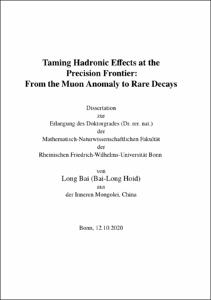Taming Hadronic Effects at the Precision Frontier: From the Muon Anomaly to Rare Decays

Taming Hadronic Effects at the Precision Frontier: From the Muon Anomaly to Rare Decays

| dc.contributor.advisor | Kubis, Bastian | |
| dc.contributor.author | Bai, Long | |
| dc.date.accessioned | 2021-02-01T12:27:09Z | |
| dc.date.available | 2021-02-01T12:27:09Z | |
| dc.date.issued | 01.02.2021 | |
| dc.identifier.uri | https://hdl.handle.net/20.500.11811/8906 | |
| dc.description.abstract | The strong interaction, one of the indispensable pillars of the Standard Model of particle physics, poses challenges at low energies because of the phase transition and the confinement nature of its underlying theory, quantum chromodynamics. Therefore, unveiling the emergent dynamics of its degrees of freedom at low energies, hadrons, and their interactions are of the essence at the low-energy precision frontier of the Standard Model. In this thesis, we pursue a model-independent and high-precision description of the low-energy hadronic effects in the anomalous magnetic moment of the muon (g−2)μ and the rare leptonic decay of the neutral pion π0 → e+e−. The approach is based on a synergy between general principles of the S-matrix, dispersion relations, low-energy theorems, and perturbative quantum chromodynamics.
In the first part, we investigate hadronic vacuum polarization in the muon (g−2)μ, including the contributions from the 3π and π0γ channels. The 3π channel, which constitutes the second-largest exclusive contribution to hadronic vacuum polarization and its uncertainty, is addressed using a dispersive representation of the γ* → 3π amplitude. In a similar manner, we study the reaction e+e− → π0γ based on a dispersive representation of the underlying π0 → γγ* transition form factor. The more involved pion-pole contribution to hadronic light-by-light scattering is discoursed in the second part. It is unambiguously defined by the doubly-virtual pion transition form factor. We report on a reconstruction of it from the available data, using a dispersive representation that accounts for all the low-lying singularities, reproduces the correct high- and low-energy limits, and proves suitable for the evaluation of the (g−2)μ loop integral. In the final part, we present a feasible formalism to reexamine the dilepton decay π0 → e+e−: the loop integral of the reduced amplitude is expressed in terms of the standard one-loop functions, yielding a two-dimensional integral representation suitable for the numerical treatment with the dispersively reconstructed pion transition form factor. | en |
| dc.language.iso | eng | |
| dc.rights | In Copyright | |
| dc.rights.uri | http://rightsstatements.org/vocab/InC/1.0/ | |
| dc.subject | anomalous magnetic moment | |
| dc.subject | hadronic light-by-light scattering | |
| dc.subject | form factors | |
| dc.subject | dispersion relations | |
| dc.subject | muon | |
| dc.subject | pion | |
| dc.subject.ddc | 530 Physik | |
| dc.title | Taming Hadronic Effects at the Precision Frontier: From the Muon Anomaly to Rare Decays | |
| dc.type | Dissertation oder Habilitation | |
| dc.publisher.name | Universitäts- und Landesbibliothek Bonn | |
| dc.publisher.location | Bonn | |
| dc.rights.accessRights | openAccess | |
| dc.identifier.urn | https://nbn-resolving.org/urn:nbn:de:hbz:5-60805 | |
| ulbbn.pubtype | Erstveröffentlichung | |
| ulbbnediss.affiliation.name | Rheinische Friedrich-Wilhelms-Universität Bonn | |
| ulbbnediss.affiliation.location | Bonn | |
| ulbbnediss.thesis.level | Dissertation | |
| ulbbnediss.dissID | 6080 | |
| ulbbnediss.date.accepted | 26.11.2020 | |
| ulbbnediss.institute | Mathematisch-Naturwissenschaftliche Fakultät : Fachgruppe Physik/Astronomie / Helmholtz-Institut für Strahlen- und Kernphysik (HISKP) | |
| ulbbnediss.fakultaet | Mathematisch-Naturwissenschaftliche Fakultät | |
| dc.contributor.coReferee | Meißner, Ulf-G. |
Files in this item
This item appears in the following Collection(s)
-
E-Dissertationen (4442)




